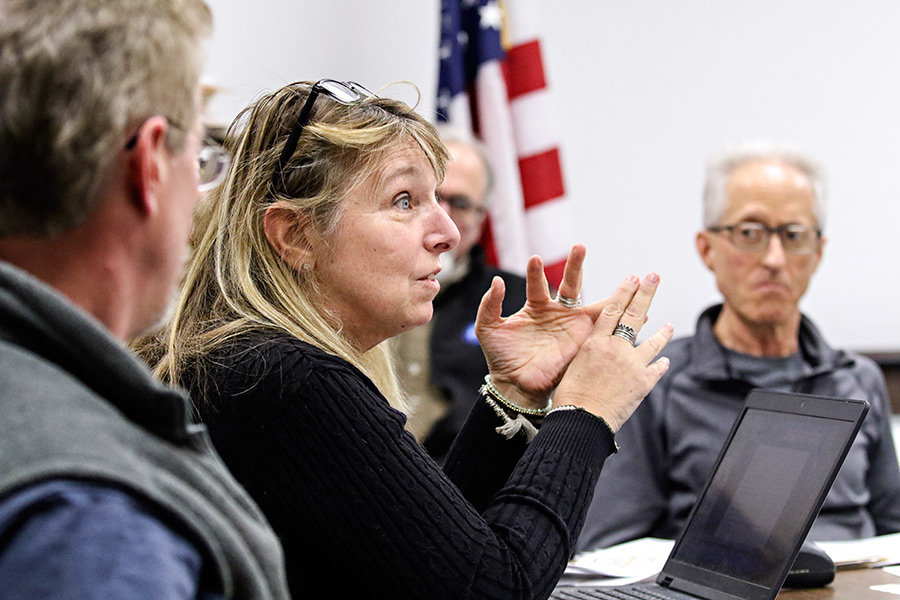Faced with Mussel Threat, Flathead Basin Commission Urges Heightened Prevention Efforts
Commission members seeking program requiring boat inspection before launching into local waters
By Dillon Tabish
Worried about the looming threat of invasive mussels infesting the headwaters of the Columbia River and the largest natural freshwater lake in the West, the Flathead Basin Commission is urging the state of Montana to increase protective measures west of the Continental Divide.
At a Feb. 2 meeting in Polson, commission members directed questions, concerns and a few critiques at Randy Arnold, the co-leader of the state’s incident command team charged with responding to last fall’s detection of aquatic invasive mussels in Tiber Reservoir. Suspect detections have also turned up in Canyon Ferry Reservoir, the Missouri River below Toston Dam, and the Milk River.
While sampling shows the Missouri River Basin is compromised, results are still pending from 117 samples collected last fall from Flathead Lake that will provide some clarity as to whether the local watershed has been infiltrated by the miniscule mussels, which cling to boats and other watercraft and can colonize rapidly, threatening ecological and economic consequences.
“If by some miracle they’re not already here, it is our last chance to protect the Flathead,” Thompson Smith, chair of the FBC, said. “What happens in this next month could literally be seen as determining what the state of this resource is going to be for generations to come. So our level of concern is profound. And I’ll be frank — my concern is that things aren’t looking really good for having that level of protection in place. Should even more strong measures be put into the mix right now?”
Last week, the state’s response team released an eight-page breakdown of its recommendations for strengthening its AIS program, including doubling the number of inspection stations, developing decontamination stations and deploying signage and marketing campaigns, among other proposals. The team is seeking a budget of $10.2 million for the list of prevention, monitoring and containment strategies, up from the current amount of roughly $2 million.
Lawmakers at the Montana Legislature, who appear largely onboard with the enhanced efforts, are crafting legislation to help fund the program by considering cost options that would spread out the costs among all users without singling out a single group, such as boaters. Lawmakers are also seeking a $5.1 million match from the federal government. Arnold said the state has begun the administrative rule process that would provide authority to enact the quarantine measures and management structure.
Among the primary changes being proposed, all out-of-state watercraft would be required to undergo an inspection before launching into a Montana waterway. Also, any watercraft leaving an infested body of water, such as Canyon Ferry, would be required to undergo decontamination before leaving the site.
The matter of increasing the number of inspection stations and deciding where, when and how to operate the stations is a complex challenge, Arnold said.
“That’s a huge topic because where those are, how they work, when they’re open, how long they’re open, is all a moving target for us right now. It’s one of the largest components of our program,” he said.
“We want to be careful and intentional and nimble, and there are challenges to the fiscal realities.”
The Flathead Basin Commission has crafted a plan specifically for this region that includes a pitch for a “pilot program” requiring all boats, whether from out of state or in state, to be inspected before entering a local body of water. The program would be similar to the one implemented by the Blackfeet Nation, which has a system that provides multi-day use stickers after an inspection. The program seeks to curtail “lake hopping,” or boats bouncing around in-state waters and potentially spreading invasive mussels.
“Multiple layers of protection are crucial. We want to add those additional layers of protection,” Smith said.
Arnold said he would review the FBC proposals, but his initial reaction was hesitancy.
“I want to make sure that I don’t put in a rule that then breaks the system because we don’t have enough capacity to meet it,” he said. “We’re already struggling to make sure we have all the money we can get.”
Arnold said the state has grappled with staffing issues in the past and is preparing for a capacity issue this spring and summer, when the increased efforts would be rolled out and inspection crews would scramble to keep up with the influx of users.
“The system will be stretched this summer,” he said. “There will be a lot of change.”
Basin commission members are in support of increased penalties for those who skip inspection stations. An idea was even floated for gating off certain lakes infested with mussels during nighttime hours to ensure daily inspections before boats launch.
“How bad do we want to keep mussels out? That’s the question,” said Chas Cartwright, a former superintendent of Glacier National Park and a member of the FBC.
FBC members also expressed frustration that the state’s initial response to the mussel detections contained “some real errors” and needed to be “more transparent.” The U.S. Bureau of Reclamation notified the state on Oct. 17 that a “suspect sample” had been discovered in Tiber Reservoir near Shelby. Additional testing later identified positive detections in Canyon Ferry. The state announced the detections on Nov. 8 and closed Tiber and Canyon Ferry on Dec. 1. Ongoing sampling and testing found “suspect” samples in the Milk River downstream of Nelson Reservoir, and the Missouri River upstream from Townsend.
Instead of dwelling on the initial response, the state and its partners should band together to protect Montana’s rivers and lakes, FBC members said.
“We may be facing our last chance of saving the Flathead,” Smith said.